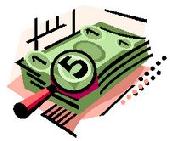
 |
|
| Financial Terms | |
| Real assets |
|
Information about financial, finance, business, accounting, payroll, inventory, investment, money, inventory control, stock trading, financial advisor, tax advisor, credit.
Main Page: credit, stock trading, finance, financial advisor, tax advisor, money, business, investment, |
Definition of Real assets
Real assetsIdentifiable assets, such as buildings, equipment, patents, and trademarks, as distinguished from a real assetsassets used to produce goods and services.
Related Terms:Realizable Revenue A revenue transaction where assets received in exchange for goods andservices are readily convertible into known amounts of cash or claims to cash. Financial assetsClaims on real assets. Tangible assetAn asset whose value depends on particular physical properties. These i nclude reproducible capital budgeting decisionDecision as to which real assets the firm should acquire. financial assetsClaims to the income generated by real assets. Also called securities. financing decisionDecision as to how to raise the money to pay for investments in real assets.  real optionsOptions embedded in real assets. Acquisition of assetsA merger or consolidation in which an acquirer purchases the selling firm's assets. After-tax real rate of returnMoney after-tax rate of return minus the inflation rate. AssetsA firm's productive resources. Assets requirementsA common element of a financial plan that describes projected capital spending and the Current assetsValue of cash, accounts receivable, inventories, marketable securities and other assets that Exchange of assetsAcquisition of another company by purchase of its assets in exchange for cash or stock. Long-term assetsValue of property, equipment and other capital assets minus the depreciation. This is an Net assetsThe difference between total assets on the one hand and current liabilities and noncapitalized longterm  Non-reproducible assetsA tangible asset with unique physical properties, like a parcel of land, a mine, or a Other current assetsValue of non-cash assets, including prepaid expenses and accounts receivable, due Publicly traded assetsassets that can be traded in a public market, such as the stock market. Quick assetsCurrent assets minus inventories. Real capitalWealth that can be represented in financial terms, such as savings account balances, financial Real cash flowA cash flow is expressed in real terms if the current, or date 0, purchasing power of the cash Real exchange ratesExchange rates that have been adjusted for the inflation differential between two countries. Real interest rateThe rate of interest excluding the effect of inflation; that is, the rate that is earned in terms Real marketThe bid and offer prices at which a dealer could do "size." Quotes in the brokers market may Real timeA real time stock or bond quote is one that states a security's most recent offer to sell or bid (buy). Realized compound yieldYield assuming that coupon payments are invested at the going market interest  Realized returnThe return that is actually earned over a given time period. REIT (real estate investment trust)real estate investment trust, which is similar to a closed-end mutual REMIC (real estate mortgage investment conduit)A pass-through tax entity that can hold mortgages Reproducible assetsA tangible asset with physical properties that can be reproduced, such as a building or Residual assetsassets that remain after sufficient assets are dedicated to meet all senior debtholder's claims in full. Return on assets (ROA)Indicator of profitability. Determined by dividing net income for the past 12 months Return on total assetsThe ratio of earnings available to common stockholders to total assets. ASSETSAnything of value that a company owns. Current assetsCash, things that will be converted into cash within a year (such as accounts receivable), and inventory. RATE OF RETURN ON TOTAL ASSETSThe percentage return or profit that management made on each dollar of assets. The formula is: AssetsThings that the business owns. Current assetsAmounts receivable by the business within a period of 12 months, including bank, debtors, inventory and prepayments. Fixed assetsThings that the business owns and are part of the business infrastructure – fixed assets may be Intangible fixed assetsNon-physical assets, e.g. customer goodwill or intellectual property (patents and trademarks). Tangible fixed assetsPhysical assets that can be seen and touched, e.g. buildings, machinery, vehicles, computers etc. AssetsItems owned by the company or expenses that have been paid for but have not been used up. Intangible assetsassets owned by the company that do not possess physical substance; they usually take the form of rights and privileges such as patents, copyrights, and franchises. current assetsCurrent refers to cash and those assets that will be turned fixed assetsAn informal term that refers to the variety of long-term operating return on assets (ROA)Although there is no single uniform practice for Fixed Assets Turnover RatioA measure of the utilization of a company's fixed assets to Real Interest RateThe rate of interest paid on an investment adjusted for inflation Return on Total Assets RatioA measure of the percentage return earned on the value of the Total Debt to Total Assets RatioSee debt ratio approximated net realizable value at split-off allocationa method of allocating joint cost to joint products using a net realizable value approacha method of accounting for by-products or scrap that requires that the net realizable value of these products be treated as a reduction in the cost of the primary products; primary product cost may be reduced by decreasing either net realizable value at split-off allocationa method of allocating joint cost to joint products that uses, as the proration base, sales value at split-off minus all costs necessary real microprofit centera center whose output has a market value realized value approacha method of accounting for byproducts or scrap that does not recognize any value for these products until they are sold; the value recognized Net realizeable valueThe expected revenue to be gained from the sale of an item or Other assetsA cluster of accounts that are listed after fixed assets on the balance sheet, real interest rateRate at which the purchasing power of an investment increases. real value of $1Purchasing power–adjusted value of a dollar. Exchange Rate, RealThe nominal exchange rate corrected for price level differences. Interest Rate, RealNominal interest rate less expected inflation. RealMeasured in base year, or constant, dollars. Contrast with nominal. Real Business Cycle TheoryBelief that business cycles arise from real shocks to the economy, such as technology advances and natural resource discoveries, and have little to do with monetary policy. Real Exchange RateExchange rate adjusted for relative price levels. Real GDPGDP expressed in base-year dollars, calculated by dividing nominal GDP by a price index. Real IncomeIncome expressed in base-year dollars, calculated by dividing nominal income by a price index. Real Money SupplyMoney supply expressed in base-year dollars, calculated by dividing the money supply by a price index. Real Rate of InterestSee interest rate, real. Real WageWage expressed in base-year dollars, calculated by dividing the money wage by a price index. Preferred Stock Stock that has a claim on assets and dividends of a corporation that are priorto that of common stock. Preferred stock typically does not carry the right to vote. Real Actions (Earnings) ManagementInvolves operational steps and not simply acceleration Realized Gains and LossesIncreases or decreases in the fair value of an asset or a liability that Realized RevenueA revenue transaction where goods and services are exchanged for cash or Current AssetsCash and other company assets that can be readily turned into cash within one year. Fixed AssetsLand, buildings, plant, equipment, and other assets acquired for carrying on the business of a company with a life exceeding one year. Normally expressed in financial accounts at cost, less accumulated depreciation. Longer-Term Fixed Assetsassets having a useful life greater than one year but the duration of the 'long term' will vary with the context in which the term is applied. Net Realizable ValueSelling price of an asset less expenses of bringing the asset into a saleable state and expenses of the sale. Personal Assetsassets, the title of which are held personally rather than in the name of some other legal entity. Asset classesCategories of assets, such as stocks, bonds, real estate and foreign securities. Fixed assetLong-lived property owned by a firm that is used by a firm in the production of its income. Liquidation valueNet amount that could be realized by selling the assets of a firm after paying the debt. Rebalancingrealigning the proportions of assets in a portfolio as needed. ACID-TEST RATIOA ratio that shows how well a company could pay its current debts using only its most liquid or “quick” assets. It’s a more pessimistic—but also realistic—measure of safety than the current ratio, because it ignores sluggish, hard-toliquidate current assets like inventory and notes receivable. Here’s the formula: liquidation valueNet proceeds that would be realized by selling the firm’s assets and paying off its creditors. Inflation TaxThe loss in purchasing power due to inflation eroding the real value of financial assets such as cash. Aggressive Capitalization PoliciesCapitalizing and reporting as assets significant portions of Valuation AllowanceA contra- or reduction account to deferred tax assets. LeasingContract granting use of real estate, equipment, or other fixed assets for a specified time in exchange for payment, usually in the form of rent. The owner of the leased property is called the lessor, the user the lessee. Lease (Credit Insurance)Contract granting use of real estate, equipment or other fixed assets for a specified period of time in exchange for payment. The owner or a leased property is the lessor and the user the lessee. Related to : financial, finance, business, accounting, payroll, inventory, investment, money, inventory control, stock trading, financial advisor, tax advisor, credit. |